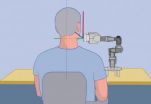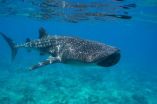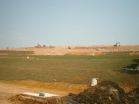(Press-News.org) TEMPE, Ariz. – A team of researchers from Arizona State University and Mayo Clinic is showing how a staple of Earth science research can be used in biomedical settings to predict the course of disease.
The researchers tested a new approach to detecting bone loss in cancer patients by using calcium isotope analysis to predict whether myeloma patients are at risk for developing bone lesions, a hallmark of the disease.
They believe they have a promising technique that could be used to chart the progression of multiple myeloma, a lethal disease that eventually impacts a patient's bones. The method could help tailor therapies to protect bone better and also act as a way to monitor for possible disease progression or recurrence.
"Multiple myeloma is a blood cancer that can cause painful and debilitating bone lesions," said Gwyneth Gordon, an Associate Research Scientist in ASU's School of Earth and Space Exploration, and co-lead author of the study. "We wanted to see if we could use isotope ratio analysis, a common technique in geochemistry, to detect the onset of disease progression."
"At present, there is no good way to track changes in bone balance except retrospectively using x-ray methods," said Ariel Anbar, a President's Professor in ASU's School of Earth and Space Exploration and the Department of Chemistry and Biochemistry. "By the time the x-rays show something the damage has been done."
"Right now, pain is usually the first indication that cancer is affecting the bones," added Rafael Fonseca, Chair of the Department of Medicine at the Mayo Clinic and a member of the research team. "If we could detect it earlier by an analysis of urine or blood in high-risk patients, it could significantly improve their care," he added.
The research team – which includes Gordon, Melanie Channon and Anbar from ASU and Jorge Monge (co-lead author), Qing Wu and Fonseca from Mayo Clinic – described the tests and their results in "Predicting multiple myeloma disease activity by analyzing natural calcium isotopic composition," in an early on-line edition (July 9) of the Nature publication Leukemia.
The technique measures the naturally occurring calcium isotopes that the researchers believe can serve as an accurate near-real-time detector of bone metabolism for multiple myeloma patients. Bone destruction in myeloma manifests itself in bone lesions, osteoporosis and fractures. The ASU-Mayo Clinic work builds on a previous NASA study by the ASU team. That research focused on healthy subjects participating in an experiment.
"This is the first demonstration that the technique has some ability to detect bone loss in patients with disease," said Anbar, a biogeochemist at ASU.
With the method, bone loss is detected by carefully analyzing the isotopes of calcium that are naturally present in blood. Isotopes are atoms of an element that differ in their masses. Patients do not need to ingest any artificial tracers and are not exposed to any radiation for the test. The only harm done with the new method, Anbar said, is a pinprick for a blood draw.
The technique makes use of a fact well known to Earth scientists but not normally used in biomedicine – different isotopes of a chemical element can react at slightly different rates. The earlier NASA study showed that when bones form the lighter isotopes of calcium enter bone a little faster than the heavier isotopes. That difference, called isotope fractionation, is the key to the method.
In healthy, active humans bone is in "balance," meaning bone is forming at about the same rate as it dissolves (resorbs). But if bone loss is occurring, then the isotopic composition of blood becomes enriched in the lighter isotopes as bones resorb more quickly than they are formed.
The effect on calcium isotopes is very small, typically less than a 0.02 percent change in the isotope ratio. But even effects that small can be measured by using precise mass spectrometry methods available at ASU. With the new test, the ASU-Mayo Clinic researchers found that there was an association between how active the disease was and the change in the isotope ratios. In addition, the isotope ratios predicted disease activity better than, and independent from, standard clinical variables.
Anbar said that while the method has worked on a small set of patients, much still needs to be done to verify initial findings and improve the efficiency of analysis.
"If the method proves to be robust after more careful validation, it could provide earlier detection of bone involvement than presently possible and also provide the possibility to monitor the effectiveness of drugs to combat bone loss."
INFORMATION:
Sources:
Ariel Anbar, ASU, (480) 965-0767
Gwyneth Gordon, ASU, (480) 727-8837
Rafael Fonseca, Mayo Clinic, (480) 301-6735
Media contacts:
Skip Derra, ASU, (480) 965-4823; skip.derra@asu.edu
Jim McVeigh, Mayo Clinic, (480) 301-4222; mcveigh@mayo.edu
ASU-Mayo researchers use calcium isotope analysis to predict myeloma progression
2014-08-12
ELSE PRESS RELEASES FROM THIS DATE:
Neutrino detectors could help curb nuclear weapons activity
2014-08-12
Physicists at the Large Hadron Collider in Switzerland and even in the fictional world of CBS' "The Big Bang Theory" look to subatomic particles called neutrinos to answer the big questions about the universe.
Now, a group of scientists led by a physics professor with the College of Science at Virginia Tech are asking whether the neutrino could provide the world with clues about nuclear proliferation in Iran and other political hotspots.
Neutrinos are produced by the decay of radioactive elements, and nuclear reactors produce large amounts of neutrinos that cannot ...
Focal blood-brain-barrier disruption with high-frequency pulsed electric fields
2014-08-12
A team of researchers from the Virginia Tech-Wake Forest University School of Biomedical Engineering and Sciences have developed a new way of using electricity to open the blood-brain-barrier (BBB). The Vascular Enabled Integrated Nanosecond pulse (VEIN pulse) procedure consists of inserting minimally invasive needle electrodes into the diseased tissue and applying multiple bursts of nanosecond pulses with alternating polarity. It is thought that the bursts disrupt tight junction proteins responsible for maintaining the integrity of the BBB without causing damage to the ...
A highly sensitive microsphere-based assay for early detection of Type I diabetes
2014-08-12
A team of researchers from the Center for Engineering in Medicine at the Massachusetts General Hospital have developed a novel fluorescence-based assay for sensitive detection of antibodies within microliter volume serum samples. This new assay is at least 50 times more sensitive than the traditional radioimmunoassay (RIA), which is the gold standard currently used in the clinic. This new technology is particularly attractive for immunological assays as it allows: 1) use of very small volumes of sample reagents (5 ¦ÌL), and 2) use of traditional analytical systems such ...
Biomarker could reveal why some develop post-traumatic stress disorder
2014-08-12
(NEW YORK – August 11) Blood expression levels of genes targeted by the stress hormones called glucocorticoids could be a physical measure, or biomarker, of risk for developing Post-Traumatic Stress Disorder (PTSD), according to a study conducted in rats by researchers at the Icahn School of Medicine at Mount Sinai and published August 11 in Proceedings of the National Academy of Sciences (PNAS). That also makes the steroid hormones' receptor, the glucocorticoid receptor, a potential target for new drugs.
Post-Traumatic Stress Disorder (PTSD) is triggered by a terrifying ...
Robotic-assisted imaging: from trans-Atlantic evaluation to help in daily practice
2014-08-12
While in Germany, Partho P. Sengupta, MD, of Icahn School of Medicine at Mount Sinai used a computer to perform a robot-assisted trans-Atlantic ultrasound examination on a person in Boston. In another study Kurt Boman, MD, of Umeå University in Sweden in collaboration with Mount Sinai, showed how a cardiologist's video e-consultation, coupled with a remote robot-assisted echocardiogram test, dramatically reduces the waiting time for a diagnosis faced by heart failure patients who live in a rural communities far from the hospital from nearly four months to less than one ...
The Maldives and the whale shark: The world's biggest fish adds value to paradise
2014-08-12
They are the largest fish in the world but the impact of this majestic and charismatic animal on the economy of the island nation of the Maldives was largely unknown. A new study by scientists of the Maldives Whale Shark Research Programme (MWSRP) reveals that a small group of whale sharks in a single Maldivian Atoll accounts for nearly 3% of the global shark ecotourism and nearly half that of the Maldives'.
"The Republic of Maldives hosts one of few known year round aggregation sites for whale sharks", said James Hancock co-author and a director of MWSRP. "We have seen ...
Is empathy in humans and apes actually different?
2014-08-12
Whether or not humans are the only empathic beings is still under debate. In a new study, researchers directly compared the 'yawn contagion' effect between humans and bonobos (our closest evolutionary cousins). By doing so they were able to directly compare the empathic abilities of ourselves with another species, and found that a close relationship between individuals is more important to their empathic response than the fact that individuals might be from the same species.
The ability to experience others' emotions is hard to quantify in any species, and, as a result, ...
Sniffing out billions in US currency smuggled across the border to Mexico
2014-08-12
SAN FRANCISCO, Aug. 12, 2014 — Criminals are smuggling an estimated $30 billion in U.S. currency into Mexico each year from the United States, but help could be on the way for border guards, researchers will report here today. The answer to the problem: a portable device that identifies specific vapors given off by U.S. paper money.
They will present the new research at the 248th National Meeting & Exposition of the American Chemical Society (ACS), the world's largest scientific society. The meeting features nearly 12,000 reports on new advances in science and other ...
Could hemp nanosheets topple graphene for making the ideal supercapacitor?
2014-08-12
SAN FRANCISCO, Aug. 12, 2014 — As hemp makes a comeback in the U.S. after a decades-long ban on its cultivation, scientists are reporting that fibers from the plant can pack as much energy and power as graphene, long-touted as the model material for supercapacitors. They're presenting their
research, which a Canadian start-up company is working on scaling up, at the 248th National Meeting & Exposition of the American Chemical Society (ACS), the world's largest scientific society.
The meeting features nearly 12,000 presentations on a wide range of science topics and ...
Stinky gases emanating from landfills could transform into clean energy
2014-08-12
SAN FRANCISCO — A new technique that transforms stinky, air-polluting landfill gas could produce the sweet smell of success as it leads to development of a fuel cell generating clean electricity for homes, offices and hospitals, researchers say. The advance would convert methane gas into hydrogen, an efficient, clean form of energy.
The researcher's report is part of the 248th National Meeting of the American Chemical Society (ACS), the world's largest scientific society.
The meeting, attended by thousands of scientists, features nearly 12,000 reports on new advances ...





